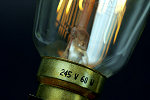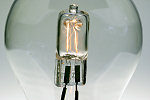What is a kiloWatt Hour?
The kWh for beginners
With the emphasis on reducing energy bills – and making them easier to understand – you might have come across the term “Kilowatt Hour” or kWh when talking about the cost of electricity or gas. A new term 'Tariff Comparison Rate' or TCR is also appearing. Understanding what these terms mean is very straightforward.
 © Alan WinstanleyIn Britain a kWh of electricity or gas is often called a “unit” and it means 1,000 Watts per Hour. A basic 1kW electric heater would therefore consume one unit or kilowatt of electricity per hour. A typical immersion heater is rated at 3kW or 3,000 watts, so it burns three units per hour. A traditional 100 watt electric light bulb uses one tenth of a unit per hour, so it takes ten hours to use a full unit.
© Alan WinstanleyIn Britain a kWh of electricity or gas is often called a “unit” and it means 1,000 Watts per Hour. A basic 1kW electric heater would therefore consume one unit or kilowatt of electricity per hour. A typical immersion heater is rated at 3kW or 3,000 watts, so it burns three units per hour. A traditional 100 watt electric light bulb uses one tenth of a unit per hour, so it takes ten hours to use a full unit.
At the time of writing a “unit” of electricity (EDF Standard Tariff) costs 12.95 pence (£0.1295 per kilowatt hour), so my 1kW electric heater costs 12.95p every hour to run. The 3kW immersion heater costs 3 units or 38.85p per hour to run and a 100W light bulb is 1.295 pence each hour. An electric cooker, though, might be rated at 12kW – yikes, that’s 12,000 watts, which uses up to 12 units totalling £1.55 per hour!
As the immersion heater has a thermostat it might be switched off (guessing) for 25% of the time, so it costs 9.7 pence an hour on average. Likewise the cooker uses thermostats to maintain temperature and save power.
Lower-energy lighting
 © Alan WinstanleyI looked briefly at low-energy light bulbs which come in two types, a CFL (compact fluorescent light) and a halogen type.
© Alan WinstanleyI looked briefly at low-energy light bulbs which come in two types, a CFL (compact fluorescent light) and a halogen type.
A small CFL might be stated as 9W power consumption, claiming it gives the equivalent light output of a traditional 46W bulb. So a CFL is five times cheaper to run than a 46W bulb would be, and it costs (9 / 1000 x 12.95p) = 0.11 pence an hour to run. It would take 111 hours to use one kWh.
To compare, an ‘old style’ 46W bulb, if there was such a thing, would therefore cost some 0.6 pence per hour to run, and after just (1000 / 46) = 22 hours, it would have used a whole unit. For the same running cost, you’d get about a fortnight’s use from a CFL compared with three evenings’ worth of light from a traditional bulb. It's also worth remembering that traditional light bulbs are hugely inefficient as light sources and they make much better room heaters. However there is of course the higher purchase price of a CFL to factor in as well.
Strangely, halogen bulbs are sometimes marketed as ‘replacements for incandescent light bulbs’ – but halogen bulbs are still incandescent! It’s just that they’re more efficient and need less power to produce the same amount of light that a traditional light bulb would.
Osram claims that its ‘Class Eco Superstar’ 46W halogen bulb is equal to a traditional 60W type, so it’s maybe a third cheaper to run. Importantly, halogens are dimmable and instant-on though, and have a more acceptable classic shape. I only use CFLs in table lights or standard lamps where I don't mind the switch-on delay.
The same idea applies to gas. My gas boiler is rated at 27.3kW heat input – gas costs 4.079 pence per kWh (3 x cheaper than electricity, note) so when the flame’s burning it’s costing £1.11 per hour to run.
In the UK it’s very much easier to shop around to get the best tariff and sites such as uSwitch will compare prices fast. We now receive energy statements showing our annual consumption, so armed with your total kWh usage per year, you’ll now be able to feed data into price comparison sites and see which has the best rates in your area. In my case, EDF Blue+ had the best deals, and compared against standard rates, the saving is maybe 3-4% p.a., better in my pocket than theirs.
Tariff Comparison Rate (TCR)
On top of this are ‘Standing Charges’, the price you pay extra per day to cover meter maintenance and readings, and ‘transport’ of gas or electricity. Even if you use zero power these charges are incurred by the providers who pass them on to you. Electricity is 18.9 pence per day and gas is 26.25 p/ day (EDF Blue+).
A new ‘Tariff Comparison Rate’ is being introduced in 2014 to help us to take account of standing charges. It annualises typical standing charges and gives you a more accurate way of comparing different offers, a bit like comparing APR’s on finance deals.

 consumer tagged
consumer tagged  energy saver bulb,
energy saver bulb,  kwh,
kwh,  tariff comparison rate
tariff comparison rate 
Reader Comments (1)
Rather off subject but I found some years ago that the gas pilot light on a room heater uses a surprising amount of gas. Well worth extinguishing it in summer. The best given off must be 100 Watt or even more.